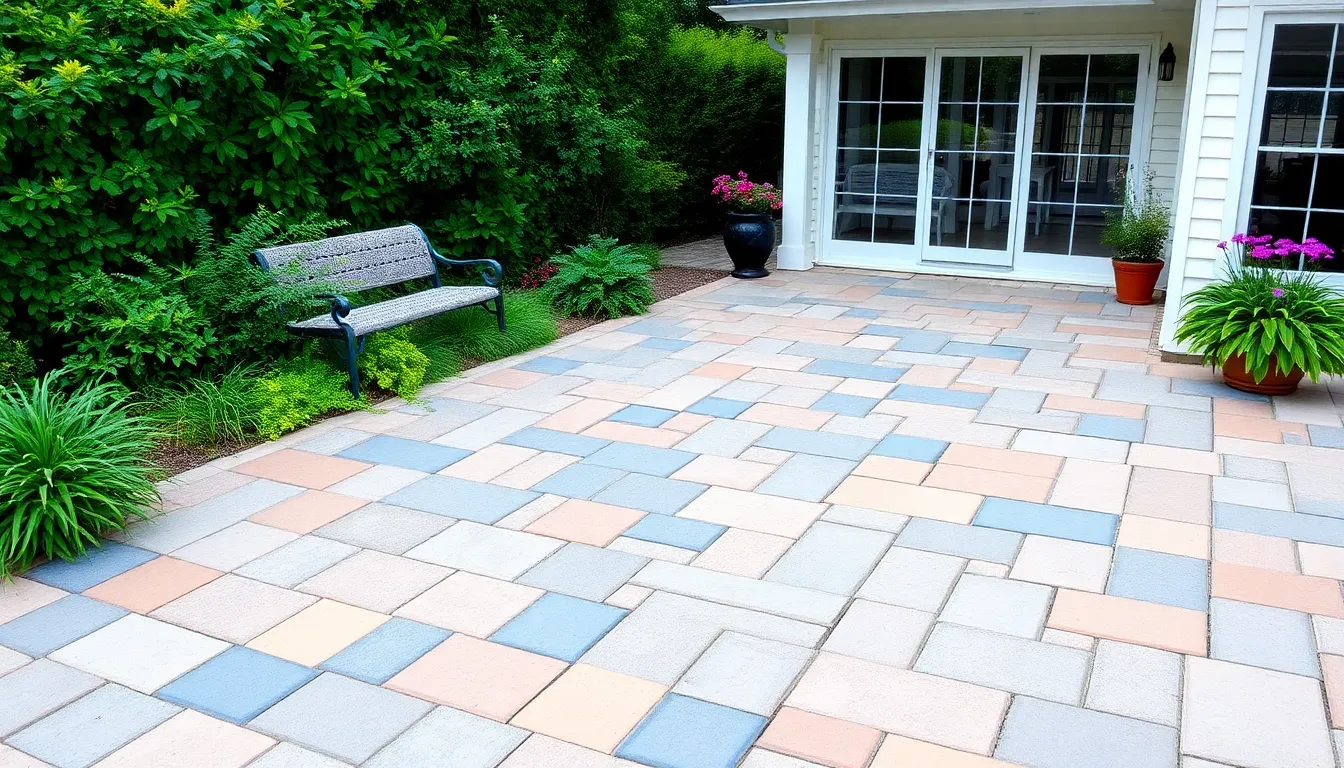Imagine transforming your outdoor space into a stunning oasis that makes your neighbors green with envy. Paver installation is the secret ingredient to achieving that coveted curb appeal without the hassle of a full-blown renovation. With a variety of styles and colors available, it’s like giving your yard a stylish makeover that even fashionistas would applaud.
Table of Contents
ToggleOverview of Paver Installation
Paver installation involves laying individual paving stones, bricks, or slabs to create durable outdoor surfaces. This process offers numerous advantages for homeowners looking to enhance their outdoor spaces. Variety plays a crucial role, as homeowners can choose from various materials, colors, and patterns for a customized look.
Preparation serves as a vital initial step. It begins with measuring the area, marking boundaries, and excavating the soil to the appropriate depth. A solid base often consists of gravel and sand, which provide drainage and support for the pavers. Compaction of the base ensures stability, minimizing shifting over time.
Next, laying pavers follows a strategic method. It’s important to install them in a consistent pattern for a professional appearance. Each paver must fit snugly against its neighbor to ensure longevity and prevent gaps that can lead to weed growth. Using edging along the perimeter helps maintain the shape of the paved area.
Joint filler completes the installation. Filling the joints with sand prevents weed growth and stabilizes the pavers. Maintenance becomes straightforward, as sweeping and occasional rinsing maintain the surface’s appearance.
Incorporating pavers enhances curb appeal and increases property value. Homeowners often find that well-installed pavers create a welcoming environment for guests and family alike. Ultimately, paver installation serves as an excellent investment for outdoor living spaces.
Benefits of Paver Installation

Paver installation offers numerous advantages for outdoor spaces, enhancing functionality and appearance.
Durability and Longevity
Durable materials characterize pavers, allowing them to withstand harsh weather and heavy foot traffic. Many pavers resist cracking, fading, and discoloration, ensuring they maintain their appearance over time. Lifespans of pavers often exceed 30 years with proper care, outperforming other materials like concrete. Homeowners appreciate that repairs are simple; they can easily replace individual pavers if needed. Routine maintenance also involves minimal effort, with sweeping and occasional washing sufficient to keep surfaces clean. Various textures and finishes contribute to their resilience against stains and slipping.
Aesthetic Appeal
Aesthetic appeal stands out with pavers, providing endless design options. From classic brick to modern stone, a wide variety of shapes, colors, and patterns exist. Homeowners can customize their outdoor spaces to match their style and complement architecture. Unique patterns create visual interest, transforming ordinary areas into inviting environments. Additionally, pavers integrate well with landscaping, blending seamlessly with gardens and walkways. This transformation enhances curb appeal and entices guests. Customization allows for personal expression while adding value to properties.
Types of Pavers
Pavers come in various materials, styles, and finishes, offering versatile options for outdoor spaces. Each type provides unique characteristics to enhance aesthetics and functionality.
Concrete Pavers
Concrete pavers are popular due to their affordability and versatility. These pavers come in multiple shapes, colors, and sizes, making customization easy. Durability marks concrete pavers, enabling them to withstand heavy traffic and harsh weather conditions. Their non-slip surface enhances safety in outdoor areas, while they require minimal maintenance. Additionally, the installation process is straightforward, allowing for quick transformation of patios and walkways.
Natural Stone Pavers
Natural stone pavers provide an elegant and timeless look for outdoor spaces. Varieties such as flagstone, slate, and granite offer unique textures and colors that create a sophisticated appearance. These pavers are durable and can endure extreme weather, lasting for decades. Their natural variability adds charm, as no two pieces look exactly the same. Installing natural stone pavers often requires skilled labor for proper alignment, contributing to their higher cost compared to manufactured options.
Clay Pavers
Clay pavers offer a classic aesthetic with their rich colors and unique textures. Often known for their strength and longevity, these pavers develop a natural patina over time, enhancing their visual appeal. These materials are resistant to fading, making them ideal for sunlight-exposed areas. Clay pavers also provide excellent rainwater drainage, promoting sustainable landscaping practices. Their installation involves precise craftsmanship to maintain a uniform look, ensuring that outdoor spaces reflect quality and style.
The Paver Installation Process
The paver installation process encompasses several key steps, ensuring a durable and visually appealing outcome.
Site Preparation
Site preparation involves thorough planning and groundwork. Measuring the designated area accurately sets a solid foundation. Marking boundaries with stakes or lines clearly defines the layout. Excavation of the soil follows, removing any existing grass or debris. The depth typically ranges from 4 to 8 inches, catering to the paver thickness and the anticipated load. A well-prepared site guarantees optimal drainage and stability for the installed pavers.
Laying the Pavers
Laying pavers requires strategic placement for both beauty and function. Starting from one edge, each paver sits snugly against its neighbor, creating a uniform appearance. Patterns may differ, whether opting for a traditional or contemporary look. A rubber mallet aids in ensuring secure placement without damaging the pavers. Gaps should remain minimal, preventing weed growth and enhancing longevity. Regularly checking alignment maintains an aesthetically pleasing surface.
Jointing and Sealing
Jointing and sealing contribute crucially to the paver installation process. Filling joints with sand or polymeric material stabilizes the pavers and prevents movement. A broom sweeps excess joint filler, ensuring even distribution. After jointing, it’s beneficial to mist the area lightly, activating the polymeric sand if used. Sealing the entire surface provides added protection against stains and enhances color longevity. Many homeowners admire this step, as it safeguards the investment and elevates the overall appearance of their outdoor space.
Common Mistakes to Avoid
Many homeowners encounter challenges during paver installation that can compromise the overall quality and longevity of the project. Ignoring proper drainage can lead to water pooling, which damages pavers over time. Insufficient base preparation often results in uneven surfaces; without a solid foundation of gravel and sand, pavers may settle or shift.
Failing to maintain consistent spacing is another common oversight. It’s essential to ensure that pavers fit snugly together, reducing gaps that allow for weed growth. Skipping the edging can cause the shape of the paved area to become distorted, leading to edge erosion.
Choosing the wrong type of paver for specific areas can impact durability and aesthetics. For instance, using heavy-duty concrete pavers for a walkway subject to high foot traffic can yield favorable results, while lighter pavers may not withstand the same level of wear.
Neglecting joint filler is also a mistake; without adequate sand in the joints, pavers might shift and become unstable. Regular maintenance, including sweeping and rinsing, goes a long way. Overlooking this step can allow dirt and debris accumulation, which detracts from visual appeal.
Whether undertaking a DIY installation or hiring professionals, awareness of these common errors helps ensure a successful project. Knowledge about effective installation can prevent costly repairs and extend the lifespan of the pavers. Always prioritize proper techniques and materials in any paver project for the best results.
Maintenance Tips for Paved Surfaces
Maintaining paved surfaces ensures their durability and aesthetic appeal. Regular sweeping prevents dirt and debris buildup, which can lead to stains. Rinsing with a hose removes loose dirt, keeping the surface clean.
Inspecting joints every few months helps identify any cracks or loose pavers. If any issues arise, replacing damaged pavers quickly prevents further problems. Sealing pavers every few years protects against stains and weathering, prolonging their lifespan.
Applying weed control solutions prevents unwanted growth between pavers, which can detract from their appearance. Additional care for specific materials also contributes to longevity. For instance, natural stone may require specialized cleaners to maintain its finish.
Using mats or rugs in high-traffic areas reduces wear and tear on pavers. Noticing signs of settling or shifting means addressing drainage issues before they escalate.
Following a seasonal maintenance checklist keeps surfaces in prime condition year-round. Cleaning after winter eliminates salt residues that can deteriorate paver materials, while checking for cracks after summer heat helps catch damages early.
For optimal results, homeowners should prioritize these maintenance tasks. Establishing a routine ensures that paved surfaces remain attractive and functional for years.
Paver installation offers an effective way to enhance outdoor spaces while boosting property value. With various materials and designs available homeowners can create unique environments that reflect their personal style. Proper installation and maintenance are crucial for ensuring longevity and performance. By avoiding common pitfalls and following best practices homeowners can enjoy beautiful and functional paved areas for decades. Investing time and effort into this project not only elevates curb appeal but also transforms outdoor living experiences. With the right approach pavers become a lasting asset that enriches any landscape.






